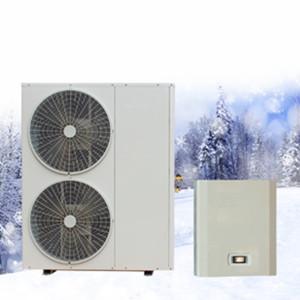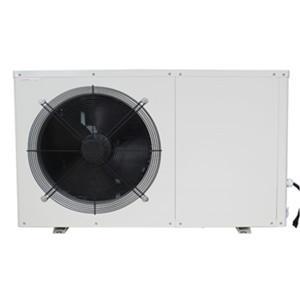Air Source Heat Pump Thermostat Settings
If you're tired of high energy bills, consider an eco-friendly alternative to heating your surroundings: an air-source heat pump. They are innovative devices that use outdoor air to generate heat, making your home comfortable and warm during the colder seasons. Since it is an air-to-water heat pump type (rather than air-to-air), it also has a minimum outlet temperature and maximum water temperature that can be achieved if the heat pump is to be utilized for cooling.
The temperature range of a heat pump is a great factor to consider if you need to keep your home comfortable year-round. Heat pump equipment moves hot air from one place to another, providing efficient cooling in the summer and efficient heating in the winter.
Homeowners need to familiarize themselves with the standard components of a heat pump unit, including the temperatures at which it fails. look carefully:
Air source heat pump
You can use these electrical devices to transfer heat energy from one place to another. These appliances naturally absorb heat from the outdoor air and transfer it to heat indoors and provide hot water. However, heat pumps have a basic outside air temperature range within which you can effectively extract heat, and they may not work effectively once the temperature exceeds that range.
The heat pump's maximum outlet temperature (for heating) and minimum outlet temperature (for cooling) are additional features. Although heat pump models and manufacturers may have different maximum and minimum temperature ranges for operating and outlet temperatures, they generally operate within a basic temperature range.
Typically, a heat pump can operate at temperatures as low as about -4°F (-20°C) and as high as about 68°F (20°C) for outdoor air temperatures. The output temperature of an air-to-water heat pump can reach approximately 140°F (60°C) for heating and approximately 41°F (5°C) for cooling.
Learn how air source heat pumps work
Before setting it up properly, it's important to understand how your new heat pump unit is different from other housewarming options you may have used. The heat generated by a traditional gas-fired furnace is transferred to your home through the ducts of the furnace blower. Heat pump units also have ducts but do not blow air through them at regular intervals. Instead, the pump constantly moves air.
Heat pump equipment transfers heat from the outdoors into your home. They can only do this when the outside temperature is above freezing. Once the temperature drops below freezing, the device uses backup components, which consumes more power.

1. Learn how to set the correct heat pump temperature
You are the only one who can determine the ideal heat pump temperature setting for your house. However, the Department of Energy recommends that people maintain system temperatures around 68 degrees Fahrenheit.
The temperature must keep you comfortable and allow the system to operate effectively once your home is finished and your family is up and running. Use this as a starting point, then follow the tips below to make adjustments.
2. Keep the exact temperature in mind when setting
To heat your home, a gas furnace intermittently shoots air through a system of ducts. However, because they don't constantly pump hot air into the house, the hot air they release is usually hotter than the air produced by a heat pump.
A traditional furnace blows air at 120 degrees, while a heat pump uses air at 90-100 degrees. Note that once you set the temperature with a heat pump, a small amount of heat can go a long way because air is continuously directed into your home. You have to aim for a heat pump temperature setting that gives you the feel you need.
3. The heat pump is expected to be used for a longer period
Another way to differentiate between heat pumps and gas-powered equipment is efficiency. Heat pump equipment is more efficient throughout its operation. With this mark, no matter what setting you put your heat pump on, you'll probably want it to run significantly longer than your furnace's cycle setting.
Just like choosing a new optimal temperature, it takes some trial and error to know which setting works best for your home.
You've noticed that most homeowners turn off their heat to reduce their monthly bills. To ensure cost savings and high efficiency, it is recommended that you turn off the heat pump and keep the thermostat constant (or lowered by no more than 1 or 2 degrees Celsius).
When you shut down the system, the heat pump has to work harder during the colder months and consume more electricity to get back to its peak performance level.
4. Use an immersion timer
Air source heat pumps mainly heat hot water efficiently every year. In many homes, the hot water temperature is usually set at around 47°C via a cylinder thermostat. When adjusting, the temperature is increased unnecessarily and operating costs are increased.
Instead of increasing heating bills, heat pump homeowners must use an immersion timer during cold weather, which allows one to use it to "increase" the water temperature: an extremely cost-effective method.
The amount of warm water required by the residence will determine how often the immersion timer is "boosted", although twice a day is typical.
This option is beneficial when the heat pump is under greater pressure, such as when family guests require additional hot water. If there is a lot of snow, keep the area around the heat pump clear, as blocked airflow can prevent the unit from functioning properly.
5. Leave the thermostat alone
Homes with blast furnaces may spend a lot of time looking for ways to save cash on the equipment. This process usually means keeping the thermostat on a lower temperature to save some money. However, this technology is not ideal for heat pump equipment.
These appliances take longer to heat a home than gas furnace-powered appliances, which means they naturally take longer. Additionally, setting the temperature very low may mean firing up the heat pump's backup element, which will consume more power instead of less. Again, aim for the temperature you want your home to feel and regulate.
Purchasing a smart thermostat has many advantages for your cooling and heating requirements. To save on utility bills, you can program your system to cool or heat your home when it's occupied.
With clever temperature planning, you can significantly increase your heat pump efficiency through enhanced temperature control. You can set a timer to activate the heat pump an hour before arrival so you can return to a comfortable and warm home. Additionally, you can set it to start a few hours before everyone wakes up.
Additionally, a smart thermostat can help you control the operating temperature of your heat pump no matter where you are. Simply put, you can use your phone to link to your thermostat unit for remote access and control. You can also program a smart thermostat to automatically adjust temperature settings based on the weather outside.
A guide to maintaining the ideal heat pump temperature range
Here are some tips for keeping your heat pump running at peak efficiency year-round:
1. Check the heat pump
Regular monitoring is the first step in maintaining your ideal heat pump temperature range. It involves looking for any signs of deterioration, such as cracks or leaks. It is also important to look for obstructions or blockages that may prevent the free flow of air in the system.
2. Regular original filter
Dirty filters reduce system efficiency and increase energy consumption. You should clean or replace your filter every three months (or more often as needed) to maintain the efficiency of your system.
3. Adjust temperature settings
It is crucial to adjust the temperature settings according to weather conditions and the season outside. Once summer temperatures are above average, set your thermostat relatively lower than usual so your appliances don't have to work too hard.
Once winter temperatures drop below freezing, raising it to just above room temperature will keep it warm without overworking the unit.
4. Carry out home quarantine.
Poor insulation can cause a lot of heat energy to be lost and lead to higher energy bills. This is a result of the inefficiency of the heating unit. It is difficult for a heat pump to meet the demand for outdoor hot air and indoor temperature in cold seasons. The heating pattern is significantly affected. Leverage expert help to achieve long-term positive results.
5. Take away
Most homeowners need help adjusting their heat pump thermostat properly within a few months. High-temperature settings use more energy, so paying attention to your thermostat's set point is crucial when you want to keep your energy costs low. When the temperature is set too low, the heat pump may become ineffective.
The ideal temperature setting often becomes apparent over time, but the recommended temperature range is a good starting point. The guide above details recommended temperature range settings for heat pumps throughout the season to meet your heating needs without incurring high utility bills.
Last but not least, schedule expert maintenance at least twice a year (or more!).
Keep following us
Leomon is a professional heat pump manufacturer. We will publish some free tips on how to use a heat pump. Stay tuned to get the best out of your heat pump.





